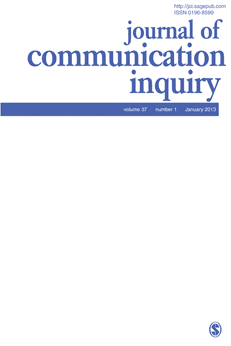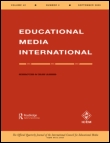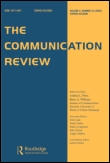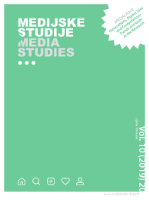
Media Literacy and Academic Research
Scope & Guideline
Navigating the complexities of media and academia.
Introduction
Aims and Scopes
- Media Literacy Education:
The journal emphasizes the importance of media literacy education across various demographics, including children, adolescents, and adults, highlighting innovative teaching methodologies and curricula. - Digital Identity and Competence:
Research on digital identity and competencies is a core focus, addressing how individuals navigate and present themselves in digital spaces, and how this impacts their engagement with media. - Impact of Media on Behavior:
Studies examining the relationship between media consumption and behavioral outcomes, particularly among youth, are prevalent, exploring issues such as addiction, consumer behavior, and social media influence. - Cultural and Contextual Analysis:
The journal frequently publishes analyses of media within specific cultural and geographical contexts, providing insights into local media practices and challenges related to media literacy. - Innovative Media Practices:
It showcases innovative practices in media, including the use of digital tools in education and the role of new media forms, such as podcasts and social media, in shaping public discourse.
Trending and Emerging
- Digital Competence and Skills:
There is an increasing focus on digital competence, particularly regarding how individuals, especially youth, develop skills to navigate and critically assess digital content. - Media Influence on Mental Health:
Research exploring the impact of media consumption on mental health, including issues like social media addiction and its psychological effects, is becoming more prominent, reflecting societal concerns. - Interactivity in Media Education:
The trend towards interactive and participatory approaches in media education is on the rise, with studies examining the effectiveness of digital tools and platforms in enhancing learning experiences. - Social Media and Consumer Behavior:
Emerging themes include the study of social media's influence on consumer behavior, particularly among younger demographics, highlighting the role of influencers and digital marketing. - Crisis Communication and Media Response:
The journal is increasingly publishing research on media's role in crisis situations, such as the COVID-19 pandemic, focusing on how media literacy can mitigate misinformation.
Declining or Waning
- Traditional Media Literacy:
There has been a noticeable decrease in research focused solely on traditional forms of media literacy, such as print and broadcast media, as the focus shifts towards digital and social media. - Static Educational Models:
The exploration of static educational models for media literacy is waning, indicating a transition towards more dynamic and interactive approaches that incorporate technology and engage learners actively. - Political Communication Analysis:
Research specifically analyzing political communication through traditional media channels is appearing less frequently, possibly due to a growing emphasis on the impact of social media and digital platforms.
Similar Journals

Media Education-Mediaobrazovanie
Navigating the Future of Learning with Media InsightsMedia Education-Mediaobrazovanie is a prominent journal that focuses on the interdisciplinary field of media education, a vital area of study in today's digital and information-driven society. Published by Cherkas Global Univ Press, this journal aims to advance the knowledge and practices surrounding the integration of media in educational settings, exploring the implications for teaching, learning, and societal engagement. Although it currently does not offer open access options, the journal is committed to providing a platform for rigorous research, theoretical discussions, and innovative practices related to media literacy and education. The journal’s ISSN is 1994-4160 and the E-ISSN is 1994-4195, ensuring that the work published reaches a broad academic audience. With the rise of digital communication and media consumption, Media Education-Mediaobrazovanie plays a critical role in preparing educators and researchers to navigate and harness the power of media in educational contexts. It serves as an essential resource for those seeking to enhance their understanding of media's impact on education and society.

Journal of Communication Inquiry
Connecting Scholars to the Pulse of Communication PracticesJournal of Communication Inquiry, published by SAGE PUBLICATIONS INC, is a premier interdisciplinary journal that serves as a vital platform for scholars and practitioners in the fields of communication, cultural studies, and the arts and humanities. With a rich history dating back to its inception in 1974, the journal has consistently upheld rigorous academic standards, reflected in its impressive rankings within the Q1 and Q2 quartiles across various disciplines according to the latest metrics. The journal's comprehensive scope encompasses theoretical and empirical research, catering to a diverse readership who are keen to explore contemporary communication issues and cultural dynamics. While the impact factor is not explicitly stated, the journal's Scopus ranks position it favorably within its categories, with notable percentiles that highlight its influence in the academic community. As an essential resource for researchers, professionals, and students alike, the Journal of Communication Inquiry invites contributions that advance the discourse surrounding communication practices and cultural phenomena, contributing to the ongoing dialogue in these evolving fields.

International Journal of Communication
Fostering innovation in communication research and practice.International Journal of Communication, published by USC Annenberg Press, is a premier open access journal dedicated to advancing the field of communication studies. Since its inception in 2007, the journal has provided a vital platform for researchers, professionals, and students to engage with cutting-edge research, theoretical frameworks, and empirical studies. With an impressive Q1 quartile ranking in Communication for 2023 and a notable Scopus rank of 156 out of 511 in the Social Sciences Communication category, the journal consistently contributes to high-quality scholarly discourse. It covers a wide array of topics, making it a crucial resource for those looking to stay informed about the latest developments in communication research. The journal's commitment to open access enhances its reach and impact, fostering a global community of academics and practitioners dedicated to exploring the complexities of communication in contemporary society. This makes the International Journal of Communication an essential read for anyone interested in understanding the dynamics of communication today.

Educational Media International
Innovating educational practices through media insights.Educational Media International, published by Routledge Journals, Taylor & Francis Ltd, is a premier journal in the interdisciplinary fields of Communication and Education, with a commendable Q2 ranking in both categories as of 2023. Established in 1978, this journal serves as a significant platform for the dissemination of innovative research that explores the evolving intersection of media technologies and educational practices. With an emphasis on both theoretical and practical applications, it addresses crucial topics such as digital learning environments, multimedia educational resources, and the impact of social media on education, making it an essential resource for researchers, professionals, and students alike. Located in the United Kingdom, Educational Media International not only contributes to the academic discourse but also reflects global trends and challenges in education, fostering a deeper understanding of the vital role media plays in shaping learning experiences worldwide.

Information Communication & Society
Illuminating Contemporary Issues in Digital CommunicationInformation Communication & Society, published by Routledge Journals, Taylor & Francis Ltd, is a premier journal in the fields of communication and library and information sciences, boasting an impressive impact factor and consistently high rankings in Scopus, including Rank #18/511 in Communication and Rank #14/280 in Library and Information Sciences for 2023. With its focus on the dynamic interplay between information technology and society, the journal serves as a vital platform for researchers, professionals, and students, facilitating the discussion of contemporary issues that shape digital environments. Since its inception in 2001 and converging from 2005 to 2024, the journal has maintained a rigorous peer-review process to ensure that it publishes high-quality research that contributes to ongoing debates and developments in the digital age. Although it does not offer open access, the journal's esteemed reputation and Q1 categorization underscore its impact within the academic community, making it an essential resource for anyone interested in the evolution of communication in the modern world.

COMMUNICATION REVIEW
Illuminating the Dynamics of Communication TheoryCOMMUNICATION REVIEW is a premier journal dedicated to the dynamic and multifaceted field of communication, published by Routledge Journals, Taylor & Francis Ltd. With both ISSN 1071-4421 and E-ISSN 1547-7487, this journal has established itself as a vital resource for researchers, professionals, and students interested in innovative theories, cutting-edge research, and critical analyses within the field. Boasting a respected Q1 quartile ranking in Communication for 2023, it operates within the top tier of its category, underscored by a strong Scopus rank of #119 out of 511, placing it in the 76th percentile among its peers. Although not an open-access publication, it provides essential insights and findings that contribute significantly to the academic discourse on communication, making it a crucial reference for anyone looking to deepen their understanding of the subject. Enthusiasts and scholars alike will find COMMUNICATION REVIEW an invaluable journal that encapsulates the evolution and breadth of communication studies throughout its publication years from 1995 to 2001 and from 2003 to 2024.

Revista de Comunicacion-Peru
Connecting Scholars, Inspiring Change.Revista de Comunicación-Perú is a distinguished open-access journal published by Universidad de Piura, with a dedicated focus on communication studies. Since its inception in 2002, the journal has provided a vital platform for researchers, professionals, and students to disseminate knowledge and foster discourse in the field of communication. As of 2023, it proudly holds a Q1 classification in the Communication category and ranks impressively in Scopus, placing at #117 out of 1304 in Cultural Studies and #160 out of 511 in Communication, demonstrating its significant impact within the academic community. The journal’s scope encompasses diverse topics related to communication, cultural discourse, and media analysis, making it an essential resource for those seeking to explore contemporary issues in these areas. With a commitment to promoting scholarly exchange, Revista de Comunicación-Perú continues to play a pivotal role in shaping the communication landscape in Peru and beyond.

Medijske Studije-Media Studies
Bridging Academic Research and Real-World Media TrendsMedijske Studije-Media Studies, an esteemed journal published by SVEUCILISTE & ZAGREBU, FAK POLITICKIH ZNANOSTI, is a pivotal platform in the field of communication studies and media research. Established in Croatia, this Open Access journal since 2010 features a diverse array of research articles that explore the multifaceted relationships between media and society. With its ISSN 1847-9758 and E-ISSN 1848-5030, the journal serves an international audience and is committed to disseminating innovative insights that drive media scholarship forward. Currently ranked in the Q3 category in Communication and Q4 in Computer Science Applications for 2023, it reflects its growing influence, capturing vital trends and analyses that resonate in both academic and practical realms. The journal's Scopus rank sits at #337 out of 511 in Social Sciences_ Communication, placing it within the 34th percentile, thus establishing its relevance in the global discourse on communication. Researchers, professionals, and students are encouraged to engage with this resource as it continues to forge connections between media studies and contemporary societal issues.

Pixel-Bit- Revista de Medios y Educacion
Bridging Technology and Pedagogy for a Digital FuturePixel-Bit: Revista de Medios y Educación is an esteemed academic journal published by UNIV SEVILLA, EDITORIAL, dedicated to advancing the fields of media and education through rigorous research and insightful analysis. With its Open Access policy established in 2010, the journal ensures that the latest findings and methodologies are readily accessible to researchers, professionals, and students worldwide. Operating from Seville, Spain, Pixel-Bit has been recognized for its significant impact within its respective fields, achieving Q2 and Q3 rankings in multiple categories such as Computer Networks and Communications, Computer Science Applications, Education, and Information Systems as of 2023. Its Scopus rankings further reflect its influence, with notable placements in the 83rd percentile in Social Sciences - Education. This journal serves as a pivotal platform for disseminating knowledge, fostering innovative practices, and bridging the gap between technology and pedagogy in an increasingly digital world.

Communication & Society-Spain
Illuminating Contemporary Issues in Communication and CultureCommunication & Society-Spain, published by Universidad de Navarra, is an esteemed open access journal dedicated to advancing scholarship in the dynamic fields of communication and cultural studies. Since its inception in 1988, the journal has maintained a commitment to disseminating high-quality research that engages with contemporary issues and contributes to the evolving discourse around communication theories and practices. With a commendable Q1 ranking in both Communication and Cultural Studies categories, it stands as a prominent source for researchers and professionals alike, reflecting its robust presence in the academic community—evidenced by its Scopus rankings placing it in the top percentiles within both fields. The journal's scope encompasses diverse perspectives and methodologies, thereby fostering interdisciplinary dialogue essential for understanding the complexities of communication in society. With a publication history that spans from 2010 to 2024 and a ranking of #87 out of 1304 in Cultural Studies, our commitment to open access ensures that impactful research is readily available to all, promoting further scholarly engagement and innovation.